Proverbs and sayings about May HORIZONTALLY: 2. May will deceive - in ... will leave.4 ....

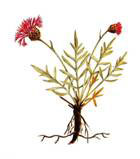
Actually Cornflower is a weed that people cultivated and turned into decorative flower. Now, with his help, numerous flower beds and rabatkas are decorated.
In order for a flower to please us with its flowering, it is necessary to follow some rules for the cultivation of Cornflower.
This plant is grown in open ground and a plot of land for it must be sunny.
Depending on the height of the plant, the distance between the holes during planting should be from 20 to 50 cm. If various flowers are planted in the flower bed, then the place for growing Cornflower should be chosen on the south side of the flower bed.
In the shade, the plant practically stops its flowering or blooms with small flowers that do not match the variety.
Fertile soil is preferred, and therefore, if a lover of this flower has the opportunity, then in the fall, complex fertilizers must be applied to the land chosen for planting Cornflowers.

A flower can grow on any soil, as absolutely undemanding in care. Water the flowers only if there is no water for a long time. Because the flower is drought-resistant and with large portions of water, rotting of the root system of the plant is possible.
Top dressing can be left out or done once in the spring by feeding a flower bed with Cornflowers with complex mineral fertilizers. Any top dressing is carried out on moist soil, so as not to scorch the root system.
planted plants in early spring or immediately after flowering in August when the hot summer weather subsides.
They are planted on open sunny plots of land, digging holes in 50 cm increments. This is necessary so that the bush has a place for the development of the vegetative mass.
After planting, you need to shed the seedlings well with warm water.
In order for the plant to grow well and please the owner with its flowering, it is worth following some simple rules:
All this will help to have beautiful flower bed blooming cornflowers.
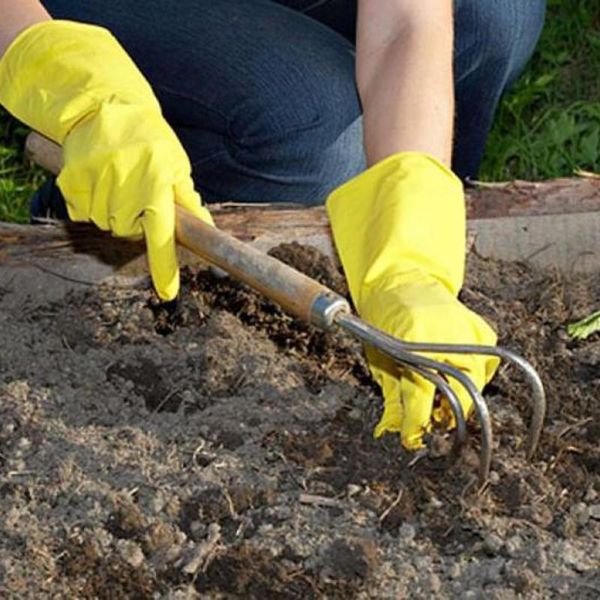
Since it was originally a field plant that was cultivated, it practically does not get sick and is not subject to pest invasion.
If perennial Cornflowers fall ill, they are simply mowed, and the rest is treated with Aktellik's solution. Annuals are not bothered at all, they are removed and destroyed off-site. And the next year they planted in a different place.
It is important to notice deviations from the norm in time in order to mow the plant.
This plant reproduces well by any method suggested below.
Seeds are propagated in two ways.
The first one is grow seedlings. In this case, seeds are planted in early March in nutritious and loose soil. Pour with warm water and cover the container with transparent glass.
Covering with glass will help create greenhouse atmosphere and seeds hatch more amicably and in large numbers.
After 20 days, when the seeds germinate, the glass is removed and watering is closely monitored. It is important that the earth does not dry out, but is not constantly wet.
Spilling is better with a spoon - this will help keep the weak sprouts still in the ground. If the street is small sun rays it is worth taking care of additional illumination of seedlings of Cornflowers so that it does not stretch.
When there are two true leaves on the seedlings, it is worth holding picking plants with its simultaneous transplantation in 200 gr. cups. Growing seedlings in this way, already in the first days of May, it will be necessary to harden it in order to plant it at the end of the month. open ground.
hardening spend for two weeks, gradually accustoming the sprouts to the open air. For this purpose, a box with seedlings is first taken out for two hours outside, but over time, the seedlings are increased.
The second method provides sowing seeds immediately in open ground. They are planted in two doses in early May and October.
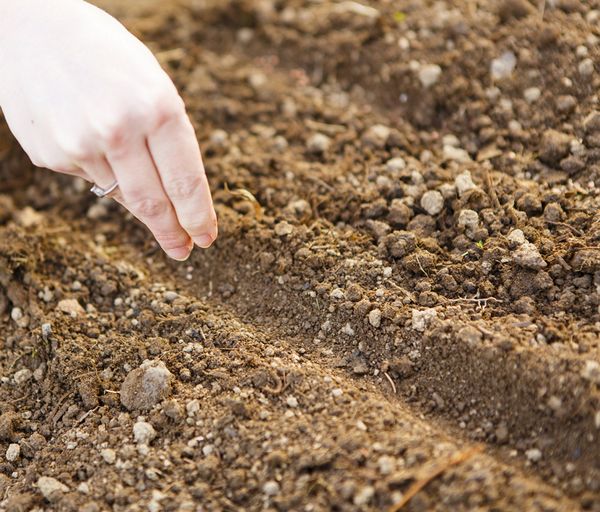
When planting seeds in early May, it is worth moistening the ground well, pour out the seeds, cover a little sowing with sand, and cover all this with a film for better seed germination. If planted in October, then sown with dry seeds in dry land.
In order for the earth to be dry in October, it is covered with a film in advance.
Seeds will sprout in the spring after the snow melts and a constant warm temperature is established.
The division of the bush is propagated, as soon as the cornflower bush has faded .
mother bush taken from the ground and divided with garden shears, so that in each part there are root system and waiting growing buds. After that, the delenki are seated in prepared holes, and well spilled with water.
If the weather is still warm, such plantings can be mulched with mowed grass.
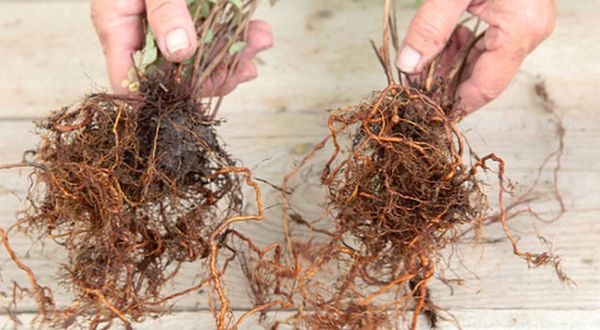
Cuttings are possible, but it is more hard way than by dividing the bush and is rarely used in practice.
In June cut cuttings and dig them into the ground where there is no sunlight. The cuttings are covered with a jar and watered all summer. In September, the cutting should form its own root system.
It is important not to flood the plant, otherwise the roots will not appear, and the cutting will rot.
Shoots can be propagated if carefully dig out part of the bush in the spring and transplanted to a new location.
It is important not to damage the mother bush.
disputes The cornflower doesn't breed because it doesn't have them.
Air layers does not multiply for lack of such.
Inoculation this is not advisable and the grass does not propagate by grafting.

The plant is greatly loved by various peoples and many beautiful legends have been composed about it. People gave it various names:
Looks like small herbaceous bush with a gray-green stem and dissected leaf blades. The shrub strongly branches, and the ends of its branches are crowned with baskets of flowers of various colors:
This flower belongs to the compound family. A biennial plant that grows, depending on the variety, from 30 to 120 cm. The stem grows straight and strongly branches. The branches are rather thin and directed upwards at an angle.
The lower leaf plates are pinnately lobed, and die off when cornflower blooms. Upper thin and long. Flowers are baskets rather dense and on long stalks. After flowering, a fruit is formed, in which the seeds are located. Flowering, depending on the variety, occurs all summer and the first month of autumn.
This plant is used to make various tinctures, decoctions, teas and other preparations helping a person maintain their health.
The infusion is made by taking 1 tbsp. petals Cornflower and pour 200 gr. boiling water. Everything is covered with a lid and wrapped for 15 minutes. After it cools down, it is filtered and taken orally as prescribed by the doctor.
Don't take infusions without consulting a doctor.
Cornflower is not considered to be the homeland of any particular country or continent, since it is found everywhere in America, in Russia, in the Caucasus, throughout Europe and North Africa.
Cornflower is used in various fields, as it has fragrant and healthy petals:
When collecting petals, do it by hand so as not to pluck the flower heads.
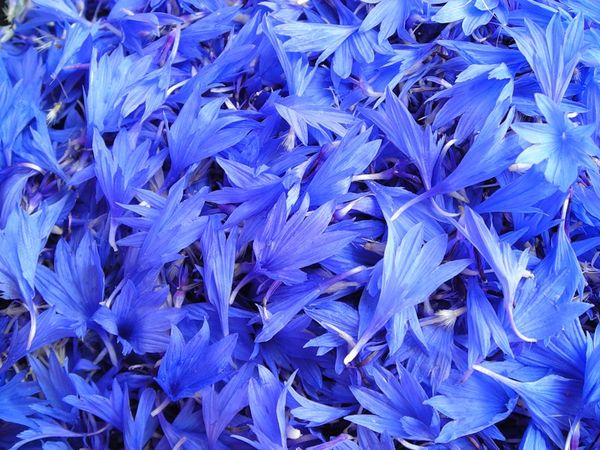
In folk medicine, various decoctions and infusions in various chronic diseases of the upper respiratory tract.
Also, these drugs are effective in the treatment of various kinds of edema. With the help of petals they treat:
Cornflower has over 500 different varieties, but gardeners have their favorite varieties.
Possesses an upright or lying stem height up to 75 cm. The leaves are slightly fluffy and strongly dissected. Flowers are collected in baskets and bloom in early summer with purple inflorescences.
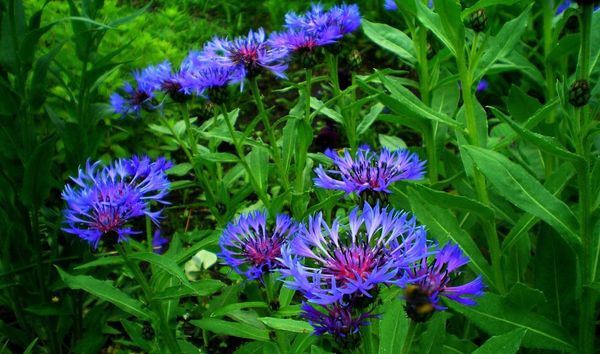
This variety of biennial Cornflower with fragrant flowers of yellow, blue, white or Pink colour. The flowers are collected in dense baskets and after flowering, seed pods appear in this place.
The height of the bush is no more than 70 cm.
Some varieties of this species are grown for cutting.
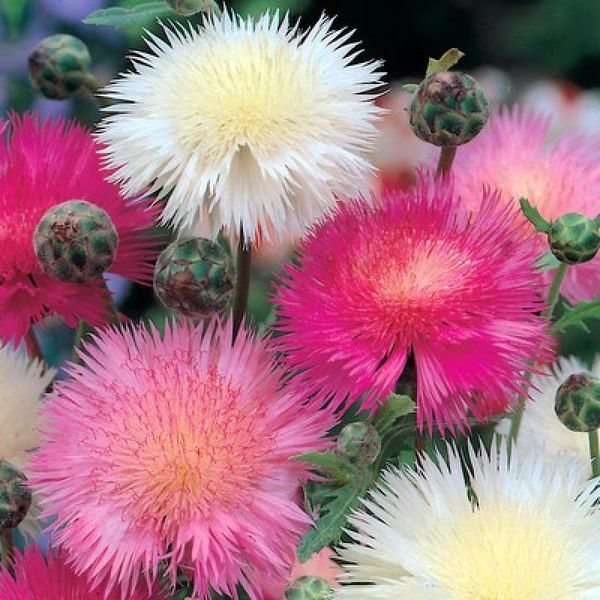
This perennial It has largest stem growth, which grow to a height of more than 100 cm. Flowers are collected in baskets and have a diameter of 7 cm.
Inflorescences are:
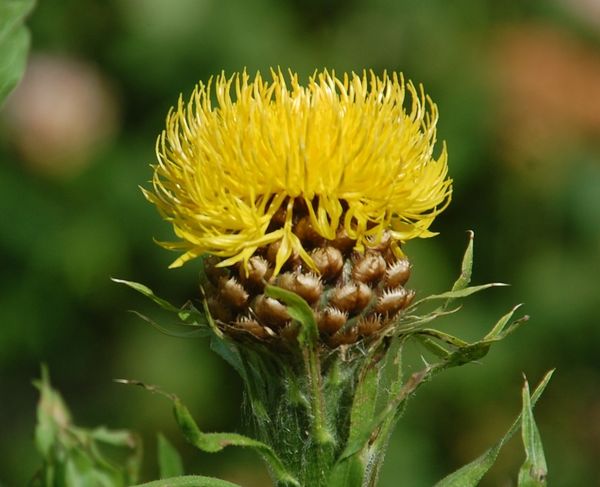
Cornflower large-headed yellow has thick and long stems more than a meter. Flowers are collected in baskets and have yellow petals 5 cm in diameter.
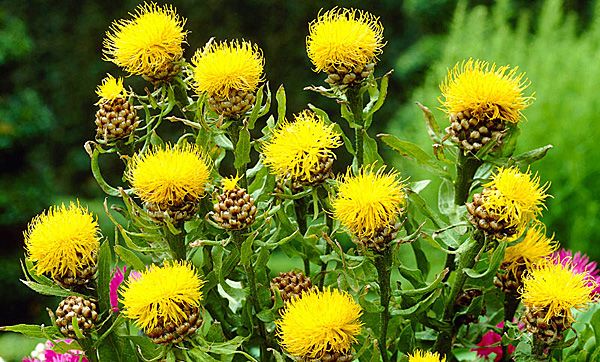
13 june 2015
cornflowers- not flashy flowers, but they have a natural charm and are well suited for creating nature-style flower beds.
Cornflowers are distributed all over the world, in Russia the name of the flower is given by the name of Vasily, which means "royal" because of the crown-like marginal flowers. The Latin name of this flower is Centaurea, which means "centaur", since according to the legend of the Greeks, the centaur Chiron healed his wounds with these flowers.
The genus Centaurea includes up to 500 species of annual and perennial herbaceous plants from the Compositae family. In cornflowers, flowers are inflorescences-baskets, in the middle of which are small tubular flowers, and on the outer edge are larger funnel-shaped flowers. The color of flowers of cornflowers is blue, blue, pink, lilac, yellow and white.
In ancient times, cornflowers were weeds for peasants, as rye fields were full of blue lights. This annual blue cornflower (Centaureacyanus) or field, and among the people it was called cherlok, voloshka, blavat, sweetheart, blue, blue, blue flower.
Cornflower blue blooms from June to autumn frosts. It has a thin strong erect stem, up to 70 cm high, branching in the upper part. Inflorescences with a diameter of 2.5-4 cm are bright blue along the edge and dark blue in the center. There are varieties with white, pink, purple, red and even two-tone flowers.
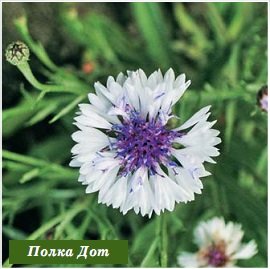
Previously, from the juice of the inner dark blue small tubular flowers that are in the center of the basket, a bright blue paint was obtained, and from the blue marginal flowers, a pale blue paint was obtained.
After flowering, cornflower seeds ripen with a fluffy tuft, so they easily scatter over long distances and multiply like a weed. Cornflowers are distinguished by minimal requirements for growing conditions, they grow well on dry and wet places, but bloom profusely only in open sunny places.
Cornflowers look great alone, as well as in a group with other bright summer flowers with poppies, daisies, esholcia, calendula. seeds undersized varieties cornflowers are included in the Moorish lawn mix, which creates a vibrant lawn of wildflowers.
annual cornflowers very unpretentious, bloom for a long time from June to September, so gardeners are happy to decorate their flower beds with cornflowers. Annual cornflowers are propagated by seeds, they are sown immediately into the ground in April - late May, they can be sown before winter. Shoots appear in a week, and after a while the seedlings are thinned out leaving a distance of 10-12 cm between plants.
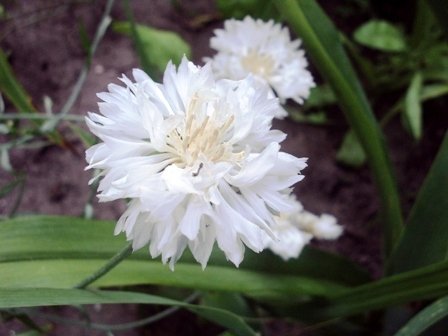
perennial cornflowers require minimal care, besides, these plants are long-lived, live up to 10 years or more without a transplant. However, some types of perennial cornflowers grow rapidly due to creeping rhizomes, overwhelming neighboring plants. But there are perennial cornflowers with a tap root, they are less aggressive and slowly spread in breadth, therefore they reproduce mainly by seeds.
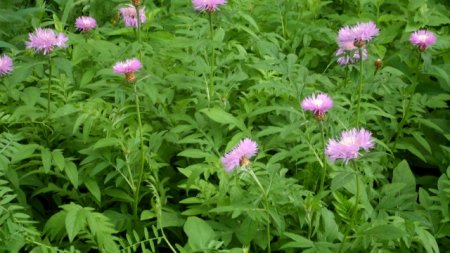
meadow cornflower (Centaureajacea) can often be found on forest edges and clearings. This plant is up to 80 cm high with strong erect stems branched at the top. At the tops of the stems, single large inflorescences-baskets with lilac-pink and white flowers are formed. The stems and leaves of the plant are covered with pile, like a cobweb, so they seem bluish. Cornflower meadow blooms from mid-summer until frost, propagated by seeds.
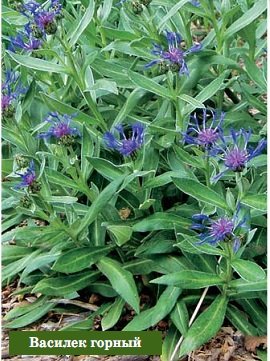
Cornflower mountain (CentaureaMontana) grows in meadows in the mountainous regions of the Pyrenees, the Alps and the Balkans. This cornflower looks impressive in gardens, but quickly grows into a dense curtain, thanks to a highly branched rhizome. Slightly branched shoots reach a height of 60 cm. Large inflorescences up to 6 cm in diameter are blue-violet, but there are varieties with white, pink and purple flowers. This species blooms profusely in May-June.
Cornflower mountain is propagated by seeds, sowing before winter or early spring, as well as by dividing the bush. Cornflower mountain winter-hardy, withstands spring frosts.

Cornflower soft (Centaureamollis) its homeland is the Carpathians, where this flower adorns the meadows. Soft cornflower has a long creeping rhizome, so it grows rapidly, forming dense thickets. Thin low shoots up to 30-35 cm long end with single blue inflorescences. It blooms all summer, is unpretentious and disease resistant. Easily propagated by cuttings of rhizomes and seeds.
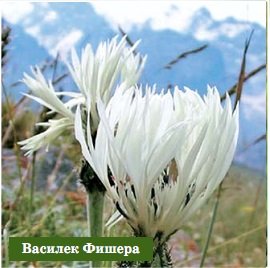
Cornflower Fisher (Centaureafischeru) comes from the Caucasus, it has unusual large inflorescences in diameter reaching 9 cm in white or lilac pink. Erect shoots 30-50 cm high have a silvery pubescence. Blooms from June to August.

Cornflower large-headed forms a tall bush up to 120 cm with large cones that open into bright yellow inflorescences-baskets. Blooms from July to mid-August. Propagated by seeds, does not tolerate the division of the bush. This tall cornflower is best placed in flower beds in the background.
Growing cornflowers
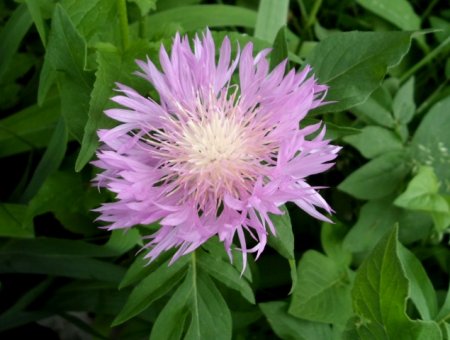 All cornflowers are light-loving plants, so they bloom well only in sunny places, under trees, even with little shading or dense planting, they grow worse.
All cornflowers are light-loving plants, so they bloom well only in sunny places, under trees, even with little shading or dense planting, they grow worse.
The soil for growing cornflowers should be well prepared, filled with humus, with a neutral reaction.
Most cornflowers prefer moderate moisture, watering these flowers only when necessary during the drought period. The rest of the care for cornflowers is weeding, loosening. Fertilizing with complex mineral fertilizer is done regularly only for cut flowers.
Cornflowers bloom in June - July. perennial species in the first year they have not yet gained strength to bloom profusely, but are already forming a lush bush of leaves. Faded shoots are cut at the level of the leaf rosette. Basal leaves of cornflowers go green under the snow.
knapweed
one of my favorite wildflowers. Its Latin name (centaurea) was adopted in the fourth century BC by the ancient Greek physician and naturalist Hippocrates. Some believe that this name comes from the Greek "kentauros" ("kentain" - to prick, "tauros" - bull). Indeed, in some species of cornflower, the leaves wrap the inflorescences, hard and prickly, and they are bypassed by cattle in pastures. But more common is the idea that the generic name of cornflowers also comes from a Greek word, but a different one - "centaur" or "centaur". And it was given in honor of the wise scientist-physician of the centaur Chiron, who was distinguished by his ability to heal wounds with herbs, in particular cornflowers.
This flower is equally loved and hated. Cornflower blue has been sung since ancient times, the eyes of loved ones are compared with it ("Oh, you, cornflower blue eyes ..."), wreaths are woven, and dwellings are decorated. The veneration of the plant is also palpable in folk names: Blakytnyanka, Vasilchik, Chichinchik, Voloshek, Patchwork. And in some areas, the cornflower is also called the "flower of the fields" or "rye cornflower". After all, it mainly "decorates" rye and wheat fields. The people even remarked: "Where there are cornflowers, there is a little bread." And then the flower becomes "the enemy of the farmers." But one old legend tells the following: “Once, cornflowers complained to the patroness of harvest and agriculture that the farmers do not pay attention to them, and everyone is busy so that the grain ears are plentiful and weighty. To which the patroness replied: “My dears, you are placed to be image of pure joy and hope. Show off among the rye and do not bow your heads when it bows its full ears. And one day, on the harvest festival, mowers will go looking for you to decorate their heads with wreaths.  Now it is no longer possible to confidently name the homeland of cornflowers, the paths along which they travel with wheat and rye for many centuries have become so confused. Most researchers believe that blue cornflowers come from the Mediterranean, some suggest that they come from Western Asia. And in North America for the first time these plants were brought from Europe as decorative flowers. There they were even called French carnations.
Now it is no longer possible to confidently name the homeland of cornflowers, the paths along which they travel with wheat and rye for many centuries have become so confused. Most researchers believe that blue cornflowers come from the Mediterranean, some suggest that they come from Western Asia. And in North America for the first time these plants were brought from Europe as decorative flowers. There they were even called French carnations.
And not only in the fields you can admire cornflowers. Of the 65 species of these plants growing in Ukraine, in addition to the field blue cornflower, 12 grow: two species are found in forest clearings, seven - on steppe and meadow-steppe slopes, three - in landfills and along roads. Very interesting yellow cornflower oriental, which, traveling steppe areas, stopped in the Western Podolia and now grows only here - and then only in a few places above the Dniester and on several small humps near the city. Extremely attractive and Marshall's cornflower. A small rosette of dove-gray leaves, almost at the ground, and lilac-pink flowers with a blond middle, like pearls or amethysts, scattered among the grasses. It blooms twice during spring and summer. Both of these types of cornflowers are protected in the Khmelnitsky region and "ask" to be protected.
There is another legend about pink, blue, white, golden and blue cornflowers: "Once upon a time happy family: mother, father and seven daughters. Not rich, but hardworking, they always rejoiced in the sun, sky and kind people. Since the house was on the edge of the village, beautiful backyard travelers often stopped. One night robbers attacked the village. They took property, livestock, destroyed everything around. And when they saw the beautiful girls, they decided to take them with them. No matter how the parents complained, they could not do anything. I only managed to have each daughter tie her braid with ribbons. Where the girls went, they left ribbons there, which turned into amazing multi-colored cornflowers. Daughters were taken farther and farther from native land. And in vain the parents looked for the girls, for the flowers grew everywhere. The old ones never had to find their beauties." 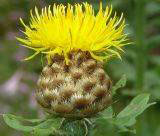 Cornflowers are attractive not only different colors, but also in size (squat Marshall cornflowers and up to 70 centimeters high cornflower). They have good decorative leaves, different shape stems. Animals eat them, insects feast on their pollen. A decoction of flowers is used to dye wool and woolen products. And in folk medicine they are used against colds, in diseases of the eyes, liver and kidneys. Cornflowers are very rich in seeds (one blue cornflower can produce 6500 seeds), from which good flowers can grow even after 10 years.
Cornflowers are attractive not only different colors, but also in size (squat Marshall cornflowers and up to 70 centimeters high cornflower). They have good decorative leaves, different shape stems. Animals eat them, insects feast on their pollen. A decoction of flowers is used to dye wool and woolen products. And in folk medicine they are used against colds, in diseases of the eyes, liver and kidneys. Cornflowers are very rich in seeds (one blue cornflower can produce 6500 seeds), from which good flowers can grow even after 10 years.
The cornflower is also a symbol of holiness, purity, friendliness and courtesy, boyish beauty and kindness. Cornflowers-fragrant medicinal herb With blue flowers, strong persistent odour. Once upon a time, peasants bred them near their homes. Cornflowers had a wide ritual use - they were placed behind icons, decorated crosses in churches, holy on Makovey (August 1), on the Savior (August 6). Ritual wreaths were woven from cornflowers for the Trinity. According to ethnographers, the sacralization of this plant is associated with legends about finding the cross of the Lord. In the place where the Jews hid the cross of the Savior, an odorous and healing herb grew, which in Ukraine was called "cornflowers". According to another legend, the plant was named "on behalf of St. Basil the Great, who allegedly loved flowers and greenery during his lifetime and always decorated his house with them." Wreaths of consecrated cornflowers were put on the heads of dead girls, and flowers were also placed in the coffin. Cornflowers were sometimes an attribute of wedding rituals, young people were sprinkled with them, they were used to make a font for children with illnesses. They also symbolize holiness, purity, beauty of the beloved.
Cornflower has an upright branched stem, 30-60 cm high. Its leaves are alternate, sessile, linear-lanceolate. Baskets of flowers on long peduncles. The marginal flowers in the basket are funnel-shaped, blue or light blue, unevenly five-toothed, and the middle flowers are tubular, purple. Hemicarp with a tuft of tenacious hairs. blooms flower cornflower in June - July. The flowers are harvested immediately, as soon as the flower baskets open, the flowers are dried (without their baskets) in dark place which is well ventilated.
Cornflower field
used in folk medicine for colds, inflammation Bladder. Decoctions of the marginal flowers of blue cornflowers are also used as eye lotions, as anti-inflammatory, and sometimes cauterizing and disinfectant. This plant is used externally and internally in the form of a decoction of its flowers also in a special eye disease called night blindness. In this treatment, one must adhere to a diet: often eat the liver with a general enhanced nutrition of fish oil.
Application methods. Decoction: one teaspoon per cup of boiling water; take 1/4 cup, three times a day; apply externally as a lotion.
If you like our site tell your friends about us!
Compositae families. A colorful plant with pink, red, white or blue flowers. Although in our minds, with the word “cornflower”, an image of a blue flower among the ears of wheat and a large field involuntarily arises. Many of us drew such flowers in childhood.
For rural farmers, this, of course, is a weed, and for a florist - cute village flowers.
Cornflower flower is an annual or perennial plant with a stem up to 80 cm high and narrow leaves. The inflorescence is terry or semi-double with a diameter of 4–5 cm. There are also perennial cornflowers with large flowers and big beautiful leaves. They bloom from June to September.
Lovely rustic flowers
Cornflower is widespread in Europe, Asia, America and even in North Africa. Up to 500 different types this flower. Varieties can be distinguished by the shape of marginal flowers and baskets of inflorescences, which are spherical and cylindrical.
Cornflower is unpretentious, resistant to cold and drought, loves the sun. Create a garden for him comfortable conditions- water, feed, planting them at a distance of 20–30 cm, and the cornflower flower (photo attached) will give you abundant and long flowering.
There are many legends associated with cornflower flowers. This blue flower has been known since ancient times. A wreath of cornflower was found in the tomb of Tutankhamen during excavations.
Ancient Greek legend says that the centaur Chiron was able to heal his wounds with cornflower juice. Hence the scientific name of this plant centaurea cuanus - centaur flower.
The Russian name is also associated with the Greek word basilicon (basil) and with the name of a young man named Vasily. According to legend, a mermaid turned him into blue flower.

Cornflowers in the field
It is known from history that I. A. Krylov loved cornflowers and in his will asked to put them in his coffin. The fact is that when Krylov in 1823 received a severe apoplexy, the doctors were powerless.
And then the empress sent him a bouquet of these flowers and asked him to bring the patient to her. Having recovered, the fabulist was deeply touched by such care and wrote the fable "Cornflower", in which he depicted himself as a simple wild flower, and the empress as the sun.
There are several varieties of cornflowers.
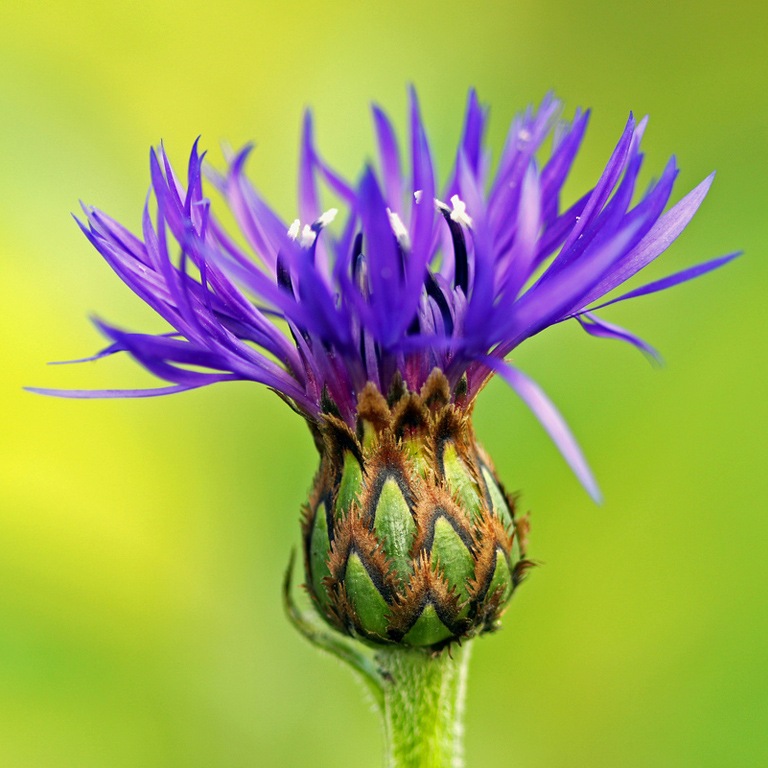
mountain cornflower
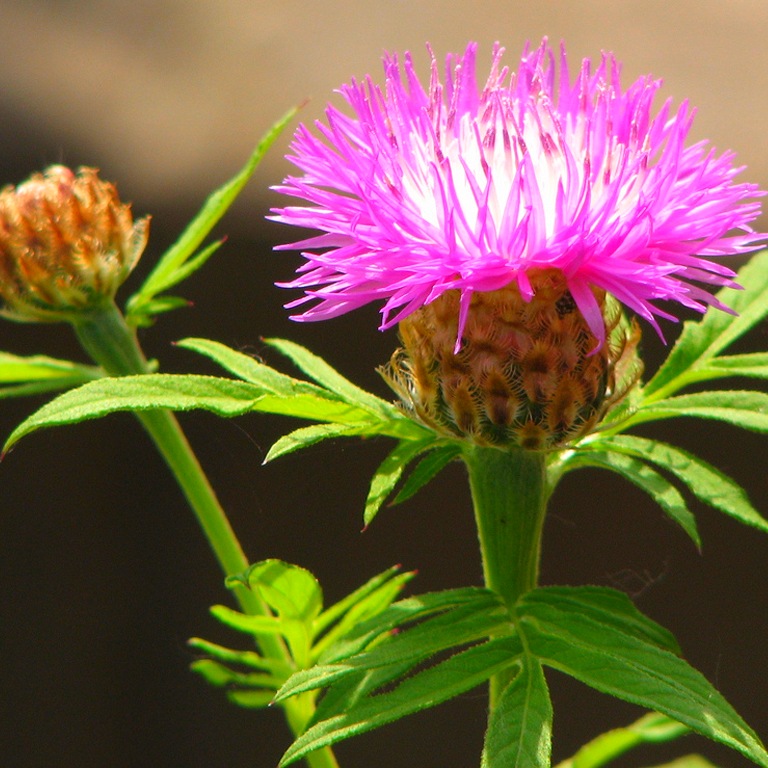
Bleached cornflower
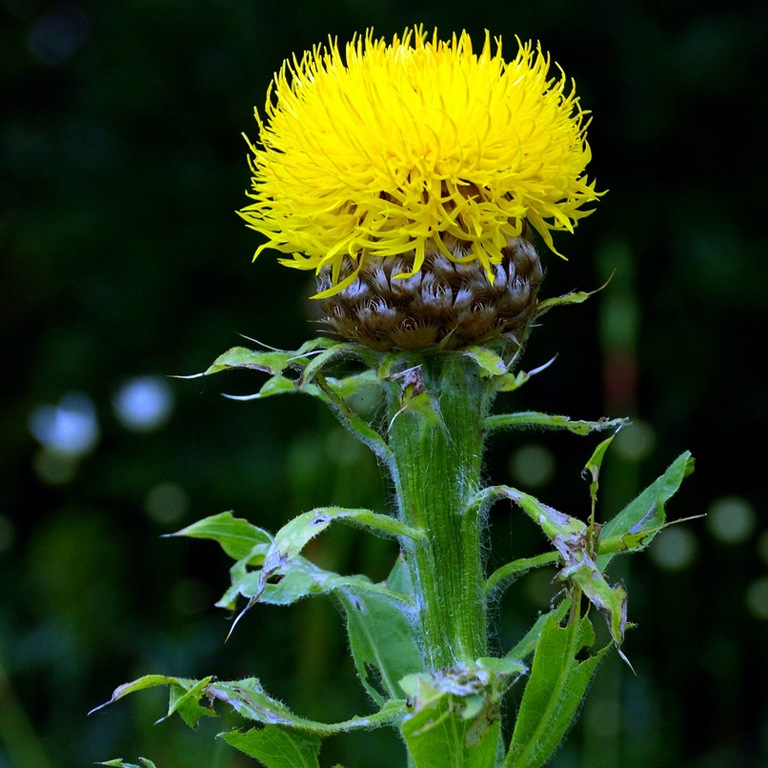
Large-headed cornflower

Cornflower beautiful

grungy cornflower
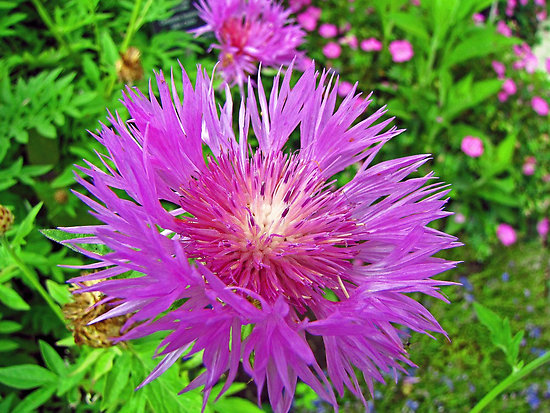
beautiful cornflower
Cornflower is also medicinal plant. His marginal flowers contain flavonoid, apiin, dyes, carotene, ascorbic acid.
The plant has a diuretic, choleretic, anti-inflammatory and analgesic effect. A decoction of cornflower inflorescences is drunk for heart disease, headache and stomach pain, for gynecological diseases, used for baths for rheumatism, eczema, diathesis, diarrhea, dropsy, jaundice and many other diseases.
Like any medicinal plant, cornflower has contraindications. Before use, consult your doctor. Decoctions and infusions of cornflower are slightly poisonous.
As we have already said, cornflowers are unpretentious and durable, they can be left without shelter for the winter. Grown outdoors in a sunny garden. If you plant them in a group with other plants, then plant them in the front row so that light evenly hits their leaves.
Use cornflowers in small groups to decorate your garden. Their tall species will look good against the background of shrubs. Cornflowers can plant slopes, so they will not only decorate, but also protect the soil from erosion.
In flowerbeds, cornflowers look great with perennial herbaceous plants, with poppy, calendula, and cosmos. They all bloom at about the same time and form a beautiful multi-colored meadow. For rock gardens, undersized types of cornflowers are suitable.
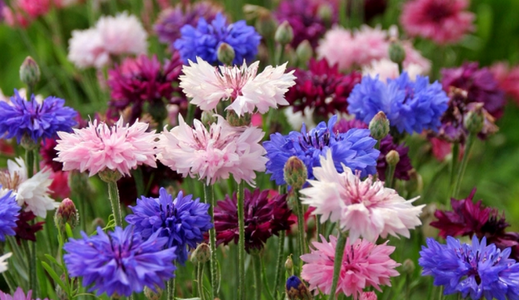
In flowerbeds, cornflowers look great with perennial herbaceous plants.
Neighbor plants for cornflowers should be discreet shades, such as blue aquilegia or dicentra, as well as silver-blue alpine eryngium or Fassen's catnip.
Annual cornflowers can also be grown in boxes on the balcony or on the windowsill outside.
Cornflowers are sown in April - May in fertile, humus-rich soil with neutral acidity. Sand is added to clay soils, if the soil is acidic, then once every three years, spray lime or dolomitic limestone (about 1 cm thick) on the soil surface. Carry out this procedure in late autumn.
Before flowering, you can carry out top dressing so that the cornflowers bloom more abundantly.

Growing cornflower from seeds
Cornflower also reproduces well by division. The transplant is carried out in August. To do this, dig out the bush chosen for division, cut off the ground shoots on it, stepping back from the root 10 cm. Rinse the roots with water and cut with a sharp knife into two or three divisions so that several daughter buds remain in each.
Perennial cornflowers are propagated by seeds, sowing them in open ground in October or early spring, in April.
If you want to collect seeds, then wait until the petals on the inflorescence fade and its center darkens. Pluck dried inflorescences and store them in a dry place for 2-3 weeks. Then shake the seeds out of the head and store at room temperature.
Cornflower, being an undemanding crop, after planting needs only watering and loosening the soil. The shape of the plant itself is decorative and does not require formation.

After planting, it needs only watering and loosening the soil
After flowering, you can cut the cornflower at the level of the rosette so as not to disturb the attractiveness of the flower garden.
Perennial plants need to be fertilized from time to time and they will remain attractive and blooming for almost 10 years.
Of the diseases, only fusarium wilt can threaten a cornflower. This is a fungal disease, so you need to process not only the plant, but also the soil. You can sprinkle the soil with ashes or fertilize with manure infusion or foundation.
The name of the cornflower from the Greek language means the centaur Chiron, who is a very famous character in myths, he is described as the only expert who thoroughly owns information about all healing properties variety of colors. Literally, the translation sounds like: "blue centaur flower." The flower is considered a weed and is often fought with because it litters the grain. Southern Europe is considered the birthplace of perennial cornflowers, and they belong to the Compositae family. Maximum temperature survival becomes +35 degrees. In spring and autumn, moderate watering should be carried out, in winter - it does not need it. Garden cornflower is a flower that prefers the bright sun, it is very much appreciated for its long and beautiful flowering, undemanding care. herbaceous plant has straight or lying stems, the height of which can reach 120 cm. Breeders managed to breed many varieties, today more than 500 are known, this variety is popular not only because of its attractive appearance, but also because it protects the earth from erosion, excellent tolerates frosty weather and is a wonderful honey plant. The garden cornflower is used in decorating areas, very often participates in group plantings, remarkably complements other types of flowers and plants, most often used as a background.
Basically, cornflowers differ from each other in their root system, flower color, long stem, leaf shape, basket. The most common types of perennial cornflower include: blue cornflower - blooms from the beginning of summer until the onset of autumn, the people have many nicknames (voloshka, patchwork, blavat).
White cornflower - is distinguished by the special tenderness of light terry petals, is very rare.
Mountain - the most famous and common species, which occurs quite often.
Yellow - attracts attention with the brightest color of the flower and a thick stem.
Large-headed - has large yellow flowers, blooms a little over a month.
Eastern - wild, spread and has been known since 1759.
Meadow - consists of large leaves and flowers of a very pleasant color (purple-pink), is very popular in Eurasia.
Bleached - refers to perennials that are famous for long period flowering, belongs to the most delicate, pretty varieties, the color is unusually pleasant (pink).
Pink - consists of large inflorescences and oblong leaves, blooms for a month and a half.
It is necessary to plant a cornflower in the spring, when the earth is already warm enough (until mid-May). The soil does not particularly matter, the main thing is that it is well loosened, and a distance is kept between the planting holes, only in this way the bush is formed and develops correctly. When planting, the buds should be at ground level (no more than three centimeters deep), the roots are well straightened. It is best to choose a sunny place, partial shade will also come down, but the flowering period will not be so long and plentiful, the seedlings will not be so colorful and the overall development will deteriorate much. Cornflower prefers freedom and a lot of free space, so it is planted immediately in open soil, the leaves should be evenly located under the sun's rays, and for group planting - suitable southern part areas, flowers should in no case close, obscure and interfere with the development of each other. The most ideal soil is considered to be soil with a high humus composition or neutral, slightly acidic.
The cultivation of flowers occurs with the help of cuttings, dividing the bush, seed method and self-seeding. Transplantation is carried out from August to September. No need to carry out abundant watering, cornflowers survive drought more easily than stagnant water.
To maintain the neatness and decorativeness of the cornflower, it is necessary: to loosen the soil, remove weeds, flower stalks and shoots (after the flowering period), on average, fertilize once every seven days. Flowers are very rarely exposed to the disease, but if a spider mite has formed, then the affected leaves will have to be disposed of. In the presence of fusarium - treat with ash or foundation.
Cornflower is widely used in folk medicine (diuretic, flu prevention), doctors advise as a medicine to improve vision, liver condition, get rid of wounds and burns. Helps to maintain a timely menstrual cycle without pain and complications. In the field of cosmetology, it helps to relieve fatigue and swelling under the eyes, soothes irritated skin.